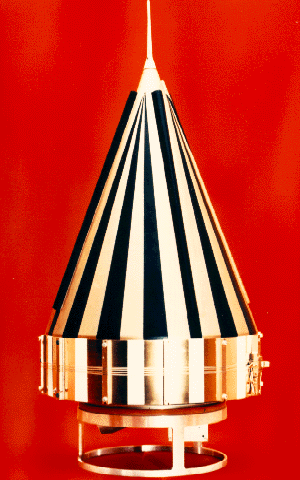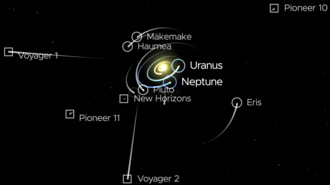Pioneer program


The Pioneer program is the name of a few unmanned space missions done by NASA between 1958 and 1978. The best-known of these probes were Pioneer 10 and 11, launched in 1972 and 1973 respectively. Both carried a plaque as shown.
The first spacecraft in Pioneer program, Pioneer 0 was launched on August 17, 1958. 77 seconds after launch the Thor engine failed and a spacecraft has failed at launch. The next spacecraft, Pioneer 1, was the first spacecraft in Pioneer Program to be launched successfully, on October 11, 1958. Like its successor, Pioneer 2, which was launched on November 8, 1958, it was launched to the Moon. The most famous spacecraft in Pioneer program, Pioneer 10 and Pioneer 11 were launched on March 2, 1972 and April 5, 1973 respectively. Both reached the Jupiter system on December 4, 1973 and December 2, 1974 respectively. Pioneer 11 became the first spacecraft to approach Saturn, on September 1, 1979. Both spacecraft aren't functional anymore, the last signal from Pioneer 11 was received on Earth on November 24, 1995 at a distance 44 AU (7 Billion km; 3 Billion miles), while the last signal from Pioneer 10 was received on January 23, 2003 at a distance of 82 AU (12 Billion km; 7.6 Billion miles) from Earth. Pioneer 10 was the most distant spacecraft from Earth until February 17, 1998 when it was passed by Voyager 1 and will be the 3rd farthest spacecraft from Earth once it'll be passed by Voyager 2 around March 2023.
Early Missions
The earliest missions were attempts to escape the pull of Earth’s gravity and to study the Moon. This included the first launch by NASA which was formed from the old NACA. These missions were carried out by the Air Force Ballistic Missile Division, Army, and NASA.
Able space probes (1958–1960)
Pioneer P-1, P-3, 5, P-30, and P-31 probe
- Most missions here are listed with their most recognised name, and alternate names in italic.
Pioneer 0
- Thor-Able 1, Pioneer
- Lunar orbiter
- Destroyed
- Failure 77 seconds after launch.
- August 17, 1958
Pioneer 1
- Thor-Able 2, Pioneer I
- Lunar orbiter, missed Moon
- Third stage partial failure.
- October 11, 1958
Pioneer 2
- Thor-Able 3, Pioneer II
- Lunar orbiter, reentry
- Third stage failure.
- November 8, 1958
Pioneer P-1
- Atlas-Able 4A, Pioneer W
- Launch vehicle lost.
- September 24, 1959
Pioneer P-3
- Atlas-Able 4, Atlas-Able 4B, Pioneer X
- November 26, 1959
Pioneer 5
- Pioneer P-2, Thor-Able 4, Pioneer V
- March 11, 1960
Pioneer P-30
- Atlas-Able 5A, Pioneer Y
- Lunar probe
- Failed to achieve lunar orbit.
- September 25, 1960
Pioneer P-31
- Atlas-Able 5B, Pioneer Z
- Lunar probe
- Lost in upper stage failure.
- December 15, 1960
Juno II lunar probes (1958–1959)
- Pioneer 3 – Lunar flyby, missed Moon due to launcher failure December 6, 1958
- Pioneer 4 – Lunar flyby, achieved Earth escape velocity, launched March 3, 1959
Later Missions (1965-1978)
Five years after the early Able space probe missions ended, NASA Ames Research Center used the Pioneer name for a new series of missions, to gather information at the inner Solar System, before the flyby missions to Jupiter and Saturn. While successful, the missions returned much poorer images than the Voyager program probes would five years later. In 1978, the end of the program saw a return to the inner Solar System, with the Pioneer Venus Orbiter and Multiprobe, this time orbiting instead of flying by planets.
The new missions were numbered beginning with Pioneer 6 (other names in brackets).
Interplanetary weather
The spacecraft in Pioneer missions 6, 7, 8, and 9 that research interplanetary space weather:
- Pioneer 6 (Pioneer A) – launched December 1965
- Pioneer 7 (Pioneer B) – launched August 1966
- Pioneer 8 (Pioneer C) – launched December 1967
- Pioneer 9 (Pioneer D) – launched November 1968 (not working since 1983)
- Pioneer E – lost in launcher failure August 1969
Pioneer 6 and Pioneer 9 are orbiting the Sun at 0.8 AU, with orbits slightly shorter than Earth. Pioneer 7 and Pioneer 8 are in solar orbits with 1.1 AU distance to the Sun. Their orbits are slightly longer than Earth's. Since the probes' orbital periods are different from that of the Earth, from time to time, they face a side of the Sun that cannot be seen from Earth.
Outer Solar System missions
- Pioneer 10 (Pioneer F) – Jupiter, interstellar space, launched March 1972
- Pioneer 11 (Pioneer G) – Jupiter, Saturn, interstellar space, launched April 1973
- Pioneer H – Jupiter mission for 1974, never launched. It is identical to Pioneers 10 and 11.
Venus project
- Pioneer Venus Orbiter (Pioneer Venus 1, Pioneer 12) – launched May 1978
- Pioneer Venus Multiprobe (Pioneer Venus 2, Pioneer 13) – launched August 1978
- Pioneer Venus Probe Bus – transport vehicle and upper atmosphere probe
- Pioneer Venus Large Probe – 300 kg parachuted probe
- Pioneer Venus North Probe – 75 kg impactor probe
- Pioneer Venus Night Probe – 75 kg impactor probe
- Pioneer Venus Day Probe – 75 kg impactor probe








